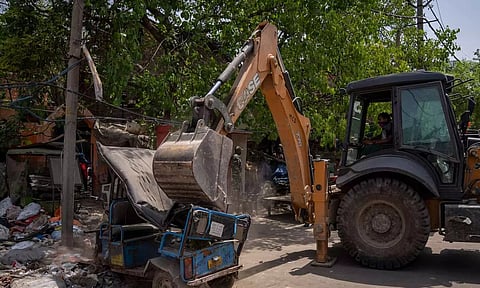

CHENNAI: The killing of five people in police firing in Haldwani in Uttarakhand last week is yet another example of the violence that accompanies Hindutva. Starting with the countrywide riots witnessed after the demolition of the Babri Masjid in 1992 to the rash of provocations reported from across India in the days before and after the pran pratishtha of the Ram temple in Ayodhya last month, violence is a barely concealed ingredient of this rage masquerading as reverence. So intrinsic has violence become to Hindutva that it expresses itself through governance just as much as political activity.
In just the past three weeks, in towns as widely flung as Vadodara, Belagavi, Jhabua, Howrah, Darbhanga, Mumbai and Pune, municipal administrations combined with street-level storm-troopers to intimidate minorities under the guise of celebrating the Sangh Parivar’s so-called triumph. While the foot soldiers planted flags atop chapels and vandalised Muslim businesses, the police and administration have done their bit by filing FIRs against the victims themselves and sending in bulldozers into minority localities.
The municipal authorities of Haldwani say there was no communal angle to the trouble witnessed there last week: The municipality sent in JCBs to tear down structures that had been built on state land. These included a mosque, a madrasa and private residences. Further, due notices had been served. What they don’t say is that these structures had been in existence for decades, and services were being provided in the locality, government schools had been built, and rates were being collected. Also, petitions to stay the municipal action were being heard in the High Court. The police on their part say it was they who were attacked first as the JCBs commenced operation. Stones that had been accumulated in anticipation of the demolition were rained on the policemen, who ran for their lives.
This action by Haldwani authorities is shown up as a ruse when seen in the context of demolition drives conducted by BJP-ruled administrations across the country in the past five years. Be it in New Delhi or Nuh, bulldozers have been used selectively in Muslim localities, destroying not only non-legal structures but legitimate ones as well, and driving hundreds of poor people out of their shelter. If applied selectively, municipal notices and pre-demolition warnings become nothing but ruses, and the demolition of minority structures nothing but state violence against its own citizens.
Unjust and targeted demolition of minority properties constitutes collective punishment when an entire community is punished for violations by a few. Administrations may argue in the courts that it is difficult to separate the innocent from the violators. But that’s not a good enough response. The state is vested with both the resources and the responsibility to carry out due process such that marginalised sections are protected and there is no escaping this mandate. It comes with the job of being elected to office.
Whether directed against minorities or Dalits, demolition drives have always been a weapon of the elite rather than the civic action they pretend to be. The bulldozer is a threat signal sent by the state’s trustees to the marginalised sections to push them off the precipice. It should not shock anyone that when pushed to the verge, the poor tend to throw a stone. Because that’s all they have.